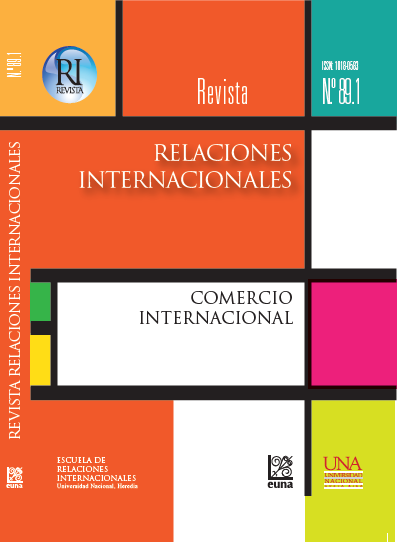Software development sector in Latin América and Asia
DOI:
https://doi.org/10.15359/ri.89-1.7Keywords:
Software Sector, Knowledge Economy, Knowledge Society, Software’s Global MarketAbstract
International Organizations such as OCDE, CEPAL, UN and the IMF have spoken in favor of the development of the Telecommunications (IT) in developing countries to generate economic and social development. Under this trend, the emergence of the concepts of Knowledge Economy and Knowledge Society serve to rethink a new kind of society based on the creation of knowledge as the main competitive advantage. The new parameters of development have focused on indicators of access to the Internet, the use of technology in society, high-tech firms and educational institutions. This article is a comparison between Mexico, Uruguay, China and Korea Republic (South Korea), specifically how these countries have developed their software sector and the actions taken to participate in the global software market.References
ARNeT. (Febrero, 2014). POLICY BRIEF BRIEF, NO. 38. Recuperado de http://www.unescap.org/sites/default/files/polbrief38.pdf
Calderón, Verónica. (2014). El boom tecnológico mexicano. Reuperado de http://tecnologia.elpais.com/tecnologia/2014/10/22/actualidad/1414011317_572594.html
Casas y Dettmer. (2013). Sociedad del conocimiento, capital intelectual y organizaciones innovadoras. En Giovanna Valente y Mónica Casalet, Instituciones, sociedad del conocimiento y mundo de trabajo. FLACSO.
CUTI. (2012). Encuesta Anual de CUTI. Recuperado de http://www.cuti.org.uy/novedades/2819-la-industria-tics-de-uruguay-crecio-un-22.html
CUTI. (2014). Acerca de Cuti. Recuperado de http://www.cuti.org.uy/acerca-de-cuti.html
Diario TI. (2014). El mercado global del software creció en 4.8 % en 2013. Diario TI. Recuperado de
http://diarioti.com/el-mercado-global-del-software-crecio-en-4-8-en-2013/76725
Gallagher and Porzecanski. (2011). Clear and Present Danger: Mexico and China in the U.S. Market (Chapter 5). En The Dragon in the Room. Stanford University Press.
Gallagher and Porzecanski. (2011). The State of the State: Industrial Reform in Mexico and China (Chapter 6 and 7). En The Dragon in the Room. Stanford University Press.
Durán, Lourdes. (2014). Augura InteQsoft tendencias de TIC. Financiero. Recuperado de http://eleconomista.com.mx/estados/2014/03/16/augura-inteqsoft-tendencias-tic
Jopson y Crabtree (2015). US probes Infosys and Tata Consultancy over H1-B visas. Recuperado de http://www.ft.com/intl/cms/s/0/a7196022-1115-11e5-9bf8-00144feabdc0.html#axzz42NMji3Qt
Kearney´s Global Service Location Index. (2011). Recuperado de http://www.atkearney.com/documents/10192/f062cfd8-ee98-4312-ae4f-0439afc10880
Lundvall, Bengt y Lorenz, Edward. (2010). Innovación y desarrollo de competencias en la economía del aprendizaje. Implicación para las políticas de innovación (Parte 1). En M.Parrilli (Coord.), Innovación y aprendizaje (pp. 45-102) España: Orkestra.
Márquez, M. (2007). Ingenieros rancheros: Elección cultural y estilo tecnológico. México: Plaza y Valdez.
MONTT, G. (2015). No sorprende el resultado de Uruguay en las pruebas PISA. En El país. Recuperado de: http://www.elpais.com.uy/informacion/no-sorprende-resultado-uruguay-pruebas.html
Networked Readiness Index 2015. (2015). Report Highlights. World Economic (Forum). Recuperado de http://reports.weforum.org/global-information-technology-report-2015/report-highlights/#heatmap
OCDE. (2014). The impact of china and india in latinamerica, challenges and opportunities. Recuperado de: http://www.oecd.org/dev/theimpactofchinaandindiainlatinamericachallengesandopportunities.htm . Consultado el 05/11/2015
ONU. (2014). UNITED NATIONS E-GOVERNMENT SURVEY . Recuperado de 2014http://unpan3.un.org/egovkb/Portals/egovkb/Documents/un/2014-Survey/E-Gov_Complete_Survey-2014.pdf
Park, H. (2015). How Outsourcing Companies Are Gaming the Visa System. The Ney York Times. Recuperado de : http://www.nytimes.com/interactive/2015/11/06/us/outsourcing-companies-dominate-h1b-visas.html?smid=fb-nytimes&smtyp=cur&_r=0
Posada, M. (17, septiembre, 2015). Se redujo crecimiento del mercado de software en AL durante 2014. Recuperado de: http://www.jornada.unam.mx/ultimas/2015/09/17/se-redujo-crecimiento-del-mercado-de-software-en-al-en-2014-5662.html.
Sainz, J. (2014). Alianzas estratégicas en la práctica. Madrid: ESIC.
Studwell, J. (2011). Where China Fits. In: How Asia Works (Chapter 4). Profile Books.
Tsuru, K. (Enero – febrero, 2013). Software legal y exportación a Estados Unidos. Comercio Exterior, 63(1), Bancomext.
T-Kearney global Rewards and Risks of Big Data. (2014). Recuperado de: https://www.atkearney.com/gbpc/global-services-location-index/past-report/-/asset_publisher/i9mYsV84tcQx/content/offshoring-opportunities-amid-economic-turbulence-the-a-t-kearney-global-services-location-index-2011/10192?_101_INSTANCE_i9mYsV84tcQx_redirect=%2Fresearch-studies%2Fglobal-services-location-index
The 2014 ATKEarney Global Services Location Index. (2014). A wealth of choises: from anywhere on earth to no location at all. Recuperado de http://www.basis.org.bd/resource/A%20Wealth%20of%20Choices.pdf
Tessler, S., Barr, A., & Hanna, N. (2003). National software industry development: considerations for government planners. EJISDC: The Electronic Journal on Information Systems in Developing Countries, 13(9), City University of Hong Kong.
UNCAPS. (2015). Rankin Internacional de e-government. Recuperado de: ghttp://unpan3.un.org/egovkb/en-us/Data-Center
UNCAT. (2012a). Según la UNCTAD se abren nuevas posibilidades para la industria local del software en los países en desarrollo. Recuperado de: http://unctad.org/es/Paginas/PressRelease.aspx?OriginalVersionID=109
UNCAT . (2012b). INFORMATION ECONOMY REPORT 2012: The Software Industry and Developing Countries.
Windows. (2015). Sistemas embebidos Windows 7. Recuperado de: http://www.microsoft.com/windowsembedded/en-us/windows-embedded-automotive-7.aspx.
Entrevistas:
Cabrera, G. (2014) Ejecutivo de Nuevos Emprendimientos y Fuentes de Financiamiento de CUTI. Entrevistado en la ciudad de Montevideo, Uruguay el 15/10/2014.
Downloads
Published
How to Cite
Issue
Section
License

Revista de Relaciones Internacionales por Universidad Nacional de Costa Rica está bajo una Licencia Creative Commons Atribución-NoComercial-SinDerivar 4.0 Internacional








1.png)







3.png)
